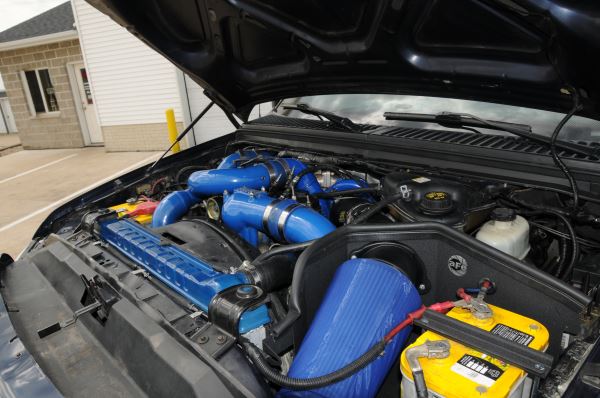 6.0L Power Stroke Engines
6.0L Power Stroke Engines
With large amounts of power and all-around smoother operation, the 6.0L Power Stroke gives owners a great ride and an amazing truck. But like the 7.3L, this newer variation isn't without its problems. The introduction of the variable geometry turbo and newer emissions equipment has brought a whole new set of issues owners may have to face during the life of their truck.
"These new systems have brought all kinds of problems to the table," Lind continued. "The good news is, the engine can be made nearly bulletproof and it will easily deliver 300k plus miles with regular maintenance."
Lind's compilation of issues for the 6.0L Ford first addresses the turbo. EGR gasses in concert with moisture flowing through the turbo can gum up the housing. With EGR/head gasket issues, the moisture can pit the inside of the turbo, making it likely that the vanes will stick. This phenomenon can cause a popping sound, low power and add to higher exhaust temperatures. Witnessing these problems can be a tell-tale sign that the turbo is under attack and in need of repair or replacement. The EGR/oil cooler combo is another issue that causes visible symptoms when damaged. Oil coolers may eventually clog, overheating the EGR cooler, causing the solder to overheat and break away. At this point, the engine will begin to use up coolant, causing white smoke and steam to appear in the exhaust on startup. Another issue to watch for is bad head gaskets. The bolts used to secure the head in place stretch over time. Under heavy load/boost situations, the heads begin to rise, compromising the head gasket. Luckily, this issue can be visibly documented and if white, crusty material is found around the expansion bottle cap, the head gasket is undoubtedly bad and has to be replaced.

The HPOP, or High Pressure Oil Pump, is more complex and intricate than what is found in its predecessor, the 7.3L. The HPOP uses a snap-to-connect fitting at the back of the pump that tends to crack over time, leaving the truck dead on the road. The pump can also seep over time, but tends to show itself when the truck has been started when the engine is already warm.The next problem commonly found in the 6.0L Ford deals with the FICM, or Fuel Injection Control Module. The FICM converts battery voltage to 48 volts, which is then used to properly run the injectors. The resistors found inside the FICM are glued in place, and when the glue's integrity is lost and begins to break away, there is also a loss of power and drivers may experience rough driving conditions. The replacement FICM comes in at around $1000, but Lind has found a way to repair it, effectively making it stronger than stock and only costing around half the price.
Lind encourages owners to put a little love and money into their engines by introducing better aftermarket parts. The use of tuners, head studs and other upgraded parts will undoubtedly cost in the short-term, but save a whole lot of time, trouble and money in the future and keep that 6.0L on the road for a long time to come.